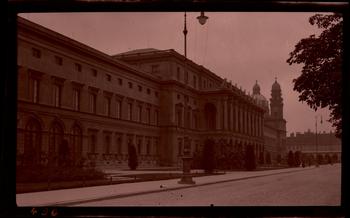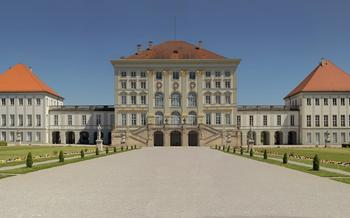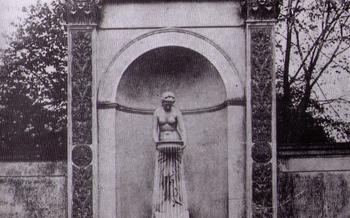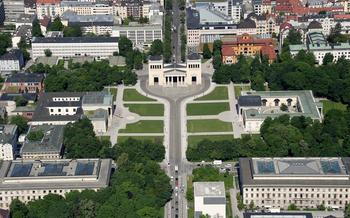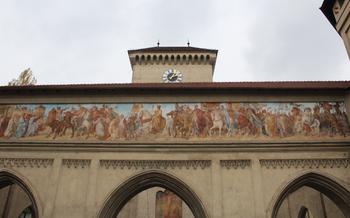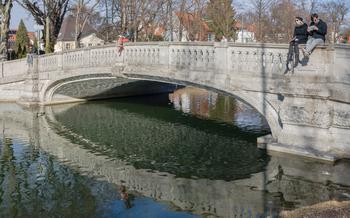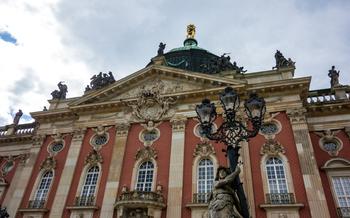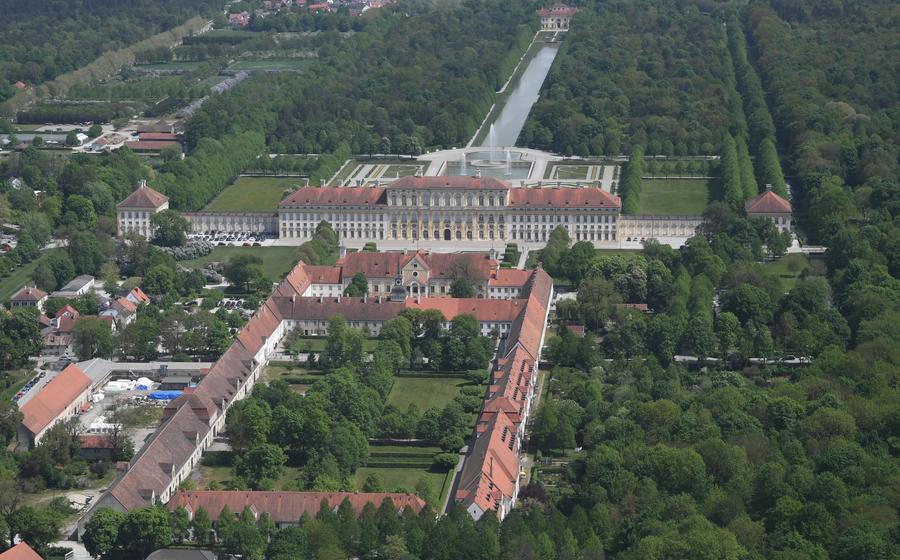
Schleissheim Palace
- Schleissheim Palace: A Majestic Palace in Munich
- Getting to the Schleissheim Palace
- Palace Tours and Exhibitions
- The Three Wings of the Palace
- The State Gallery in the New Palace
- The Porcelain Collection in the Old Palace
- The Marble Hall in the New Palace
- The Court Chapel in the Old Palace
- The Palace Gardens: A Majestic Display of Formal Beauty
- The Schleissheim Park
- The Marstallmuseum in the Park
- The Palace Café and Restaurant
- Insider Tip: Secret Garden
Schleissheim Palace: A Majestic Palace in Munich
The Schleissheim Palace is a magnificent complex of three palaces located in the Bavarian town of Oberschleissheim, just outside Munich. With its rich history, stunning architecture, and extensive gardens, it is a must-visit destination for anyone interested in art, culture, and history.
The palace's roots can be traced back to the 16th century when Duke Wilhelm V of Bavaria built the Old Palace as a hunting lodge. Over the following centuries, the palace was expanded and embellished, resulting in the construction of the New Palace in the 17th century and the Lustheim Palace in the 18th century.
The Schleissheim Palace is a captivating blend of architectural styles. The Old Palace showcases the grandeur of the Renaissance period, with its intricate facades, gables, and towers. The New Palace, built in the Baroque style, boasts an impressive entrance with a grand staircase, lavish state rooms, and a breathtaking Marble Hall. The Lustheim Palace, with its elegant Rococo architecture, served as a summer residence for the Bavarian court.
The palace's gardens and parks are equally impressive. The formal gardens surrounding the palaces feature geometric patterns, fountains, and sculptures, creating a harmonious balance between nature and architecture. The extensive Schleissheim Park offers visitors a serene retreat with walking trails, picnic areas, and a picturesque lake.
Getting to the Schleissheim Palace
Schleissheim Palace is conveniently located just outside of Munich, making it easy to reach by public transportation or car.
Public transportation:
From Munich Central Station, take the S1 suburban train to Oberschleissheim station. The journey takes about 20 minutes, and the station is a short walk from the palace.
Driving directions:
From Munich, take the A99 autobahn towards Nuremberg. Exit at Oberschleissheim-Mitte and follow the signs to the palace. The drive takes approximately 25 minutes.
Parking availability:
There is ample parking available at the palace, both for cars and buses. The parking lot is located near the entrance gate, and the fee is €3 per day.
Palace Tours and Exhibitions
The Schleissheim Palace offers a variety of guided and self-guided tours, providing visitors with insights into its rich history, architecture, and art collections.
Guided Tours
Guided tours are an excellent way to learn about the palace's history and highlights. Tours are available in German and English, and they typically last for about an hour. Visitors can join a guided tour at the palace entrance or book a private tour in advance.
Self-Guided Tours
Visitors who prefer to explore the palace at their own pace can opt for a self-guided tour. Brochures and audio guides are available in multiple languages, providing detailed information about the palace's rooms, gardens, and art collections.
Temporary Exhibitions and Special Events
In addition to the permanent exhibitions, the Schleissheim Palace regularly hosts temporary exhibitions and special events. These exhibitions showcase a wide range of art and cultural artifacts, from historical paintings to contemporary sculptures. The palace also hosts concerts, lectures, and other events throughout the year.
The Three Wings of the Palace
The Schleissheim Palace complex consists of three distinct wings: the Old Palace, the New Palace, and Lustheim Palace. Each wing showcases a unique architectural style and offers a different experience to visitors.
-
Old Palace: Embodying the grandeur of the Renaissance era, the Old Palace features a rusticated exterior, elaborate gables, and a striking tower. The Hall of Mirrors, located within the Old Palace, is an opulent masterpiece that captivates visitors with its ornate mirrors, intricate stucco work, and grand chandeliers.
-
New Palace: A shining example of Baroque architecture, the New Palace boasts an impressive façade adorned with sculptures, pilasters, and a grand entrance. The interior of the New Palace is equally impressive, with its grand staircase leading to the state rooms. These rooms are adorned with intricate frescoes, opulent chandeliers, and fine furnishings, reflecting the extravagance of the Bavarian court.
-
Lustheim Palace: Situated in the tranquil parkland, Lustheim Palace stands as a testament to the Rococo style. Its charming exterior, featuring delicate stucco work and pastel colors, exudes an air of elegance and grace. Inside, the palace is adorned with exquisite Rococo furnishings, intricate wall paintings, and a picturesque chapel. Lustheim Palace was conceived as a summer residence for the Bavarian monarchs and offered a serene retreat from the bustling court life.
The State Gallery in the New Palace
The New Palace houses the State Gallery, a renowned art collection that showcases masterpieces from the 16th to 19th centuries. Among the highlights are works by renowned artists such as Peter Paul Rubens, Rembrandt van Rijn, and Anthony van Dyck. The gallery boasts an impressive collection of paintings, sculptures, and decorative arts, offering visitors a journey through the history of European art.
The State Gallery is particularly renowned for its collection of Flemish and Dutch paintings from the 17th century. Visitors can admire the vibrant colors and intricate details of works by Rubens, such as his masterpiece "The Abduction of Proserpina." Rembrandt's "Self-Portrait with Two Circles" offers a glimpse into the artist's introspection and mastery of chiaroscuro. Van Dyck's portraits, including "Charles I of England on Horseback," capture the grandeur and elegance of the Stuart court.
In addition to the permanent collection, the State Gallery frequently hosts temporary exhibitions and special events. These exhibitions explore various themes and periods in art history, showcasing works from both established and emerging artists. Visitors can also attend lectures, workshops, and guided tours to deepen their understanding and appreciation of the artworks on display.
The Porcelain Collection in the Old Palace
Within the walls of the Old Palace, nestled amidst a treasure trove of artistic wonders, lies a collection of exquisite porcelain that captivates the hearts of visitors. Meissen, Nymphenburg, and Augarten, the renowned masters of porcelain craftsmanship, are represented here in their finest forms, showcasing the pinnacle of their artistry.
Delicate dinnerware, adorned with intricate patterns and vibrant hues, graces the display cabinets, each piece a testament to the skill and precision of the artisans who brought it to life. Graceful figurines, capturing the essence of human and animal forms with remarkable realism, stand as silent witnesses to the artistry of the past. Decorative objects, infused with a touch of whimsy and elegance, add a playful charm to the collection, transforming it into a feast for the eyes.
Displays are carefully curated to showcase the evolution of porcelain making, taking visitors on a journey through the centuries as they witness the transformation of this versatile material from its humble beginnings to its status as a symbol of luxury and refinement. Rare and unique pieces, some dating back to the early 18th century, offer a glimpse into the history and heritage of European porcelain, making this collection a must-see for any enthusiast or connoisseur.
The Marble Hall in the New Palace
The grandest room in the Schleissheim Palace is the Marble Hall, located in the New Palace. This awe-inspiring hall boasts a dazzling marble floor, intricate stucco decorations, and stunning ceiling frescoes that depict mythological scenes. The frescoes, created by the Italian artist Giovanni Battista Tiepolo, are a masterpiece of Baroque art and bring the hall to life with their vibrancy and movement.
The Marble Hall was designed to impress and serve as a fitting venue for concerts, banquets, and official receptions. Its opulent décor and spaciousness create an atmosphere of grandeur and elegance. The hall's acoustics are also remarkable, making it an ideal venue for musical performances.
Over the centuries, the Marble Hall has witnessed countless events, from lavish celebrations to important diplomatic meetings. It remains a symbol of the palace's grandeur and a testament to the artistry and craftsmanship of the Baroque era. Today, visitors can admire the hall's beauty and soak in its rich history, making it a must-see attraction within the Schleissheim Palace.
The Court Chapel in the Old Palace
Within the confines of the Old Palace, nestled amidst a tapestry of opulent chambers, lies the Court Chapel, a sanctuary of faith and artistry. Its intimate ambiance is adorned with intricate stucco decorations that dance across the walls and ceiling, creating a celestial tapestry. The altarpieces, crafted by renowned masters, emanate a divine presence, their vibrant colors and meticulous details captivating the hearts of all who behold them.
Regular religious services and concerts resonate within the sacred space, their melodies echoing through the hallowed halls, adding a layer of spirituality to the palace's rich history. The Court Chapel stands as a testament to the deep-rooted faith that once permeated the lives of the Wittelsbach dynasty and their court, inviting visitors to pause and reflect upon the enduring power of devotion.
The Palace Gardens: A Majestic Display of Formal Beauty
As you step out of the palace, the sprawling gardens beckon you with their manicured lawns, intricate geometric patterns, and an array of sculptures and fountains. These formal gardens, a hallmark of Baroque design, were meticulously planned to complement the architectural grandeur of the palace.
Stroll along the gravel paths, admiring the symmetry and precision that characterize these gardens. Perfectly trimmed hedges frame colorful flower beds, creating a vibrant tapestry of colors that changes with the seasons.
Take a moment to relax by one of the many fountains, listening to the gentle splashing of water as you soak in the tranquility of this serene oasis. The harmonious blend of nature and human artistry creates an unforgettable ambiance that transports you back in time to the era of opulence and elegance.
The Palace Gardens offer a peaceful escape from the bustling city, inviting you to unwind and reconnect with the natural world. Whether you prefer a leisurely stroll, a picnic under the shade of a majestic tree, or simply some quiet contemplation, these gardens provide the perfect setting for relaxation and rejuvenation.
The Schleissheim Park
Encompassing the Schleissheim Palace, the vast and verdant Schleissheim Park beckons with its allure, inviting visitors to embark on leisurely strolls amidst its tranquil embrace. An idyllic haven for nature enthusiasts and outdoor adventurers, the park offers a captivating tapestry of landscapes, from serene walking trails meandering through lush greenery to idyllic picnic spots dotting its expanse.
At the heart of the park, a picturesque lake shimmers, reflecting the azure sky and casting a spellbinding charm upon its surroundings. Its tranquil waters provide a sanctuary for diverse wildlife, including graceful swans and playful ducks, adding to the park's enchanting ambiance.
Whether seeking a serene escape from the urban hustle or an invigorating immersion in nature's embrace, the Schleissheim Park promises an unforgettable experience. Its myriad attractions, including the majestic palace, captivating gardens, and serene lake, ensure that visitors of all ages will find solace and delight within its verdant domain.
The Marstallmuseum in the Park
Nestled within the sprawling grounds of Schleissheim Park, the Marstallmuseum beckons equestrian enthusiasts and history buffs alike. Dedicated to the rich legacy of horse breeding and equestrian sports in Bavaria, this captivating museum offers a fascinating glimpse into the world of these majestic animals and their profound impact on human society.
As you step through the doors of the Marstallmuseum, you are greeted by an array of exhibits that showcase the evolution of horse breeding in the region. From ancient origins to modern techniques, the museum delves into the intricate history of this practice, highlighting the significance of Bavarian horses in shaping the course of history.
Among the highlights of the collection are meticulously preserved carriages, saddles, and other equestrian accoutrements that once adorned the royal stables. These exquisite artifacts provide a tangible connection to the grandeur and opulence of bygone eras, when horses played a pivotal role in transportation, warfare, and leisure activities.
Interactive exhibits engage visitors of all ages, particularly children, with hands-on experiences that bring the world of horses to life. Virtual reality simulations offer a thrilling ride through the Bavarian countryside, while educational displays illuminate the anatomy and physiology of these magnificent creatures.
Whether you are a seasoned equestrian or simply curious about the history of horses, the Marstallmuseum promises an enriching and unforgettable experience. Immerse yourself in the captivating world of these noble animals and gain a deeper appreciation for their enduring legacy.
The Palace Café and Restaurant
For a culinary treat, visit the Palace Café nestled in the Old Palace courtyard. This charming café offers a relaxed atmosphere and a menu of light snacks and beverages. Enjoy a cup of aromatic coffee or tea, accompanied by a slice of freshly baked cake or a croissant as you soak in the tranquil ambiance of the courtyard. For a more formal dining experience, head to the Restaurant in the New Palace, which serves a delectable array of Bavarian and international cuisine. The restaurant boasts an elegant interior and offers outdoor seating, allowing you to savor your meal while admiring the picturesque views of the gardens.
Insider Tip: Secret Garden
Venture beyond the bustling palace corridors and discover a hidden gem tucked away behind the Old Palace—the Secret Garden. This enchanting oasis invites you to immerse yourself in tranquility and respite. Stroll along the winding paths, surrounded by lush greenery and the gentle sound of a trickling fountain. Admire the vibrant blooms that dance in the sunlight, creating a kaleidoscope of colors. Take a moment to sit on one of the benches and soak in the serenity of this secluded paradise. The Secret Garden is a haven for those seeking a peaceful escape within the grandeur of Schleissheim Palace.
